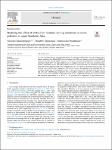Thông tin tài liệu

| Nhan đề : | Modeling the effect of VOCs from biomass burning emissions on ozone pollution in upper Southeast Asia |
| Tác giả: | Amnuaylojaroen, Teerachai |
| Người tham gia: | Macatangay, Ronald C. Khodmanee, Suratsawadee |
| Năm xuất bản : | 2019 |
| Nhà xuất bản : | Elsevier |
| Số tùng thư/báo cáo: | Heliyon,Volume 5, Issue 10 |
| Tóm tắt : | We used a Weather Research and Forecasting Model with Chemistry (WRF-CHEM) model that includes anthropogenic emissions from EDGAR-HTAP, biomass burning from FINN, and biogenic emissions from MEGAN to investigate the main volatile organic compound (VOC) ozone precursors during high levels of biomass burning emissions in March 2014 over upper Southeast Asia. A comparison between the model and ground-based measurement data shows that the WRF-CHEM model simulates the precipitation and 2 m temperature reasonably well, with index of agreement (IOA) values ranging from 0.76 to 0.78. Further, the model predicts O3, NO2, and CO fairly well, with IOA values ranging from 0.50 to 0.57. However, the magnitude of the simulated NO2 concentration was generally underestimated compared to OMI satellite observations. The model result shows that CO and VOCs such as BIGENE play an important role in atmospheric oxidation to surface O3. In addition, biomass burning emissions are responsible for increasing surface O3 by ∼1 ppmv and increasing the reaction rate of CO and BIGENE by approximately 0.5 × 106 and 1 × 106 molecules/cm3/s, respectively, in upper Southeast Asia. |
| URI: | http://tailieuso.tlu.edu.vn/handle/DHTL/8364 |
| ISSN : | 2405-8440 |
| Trong bộ sưu tập: | Tài liệu hỗ trợ nghiên cứu khoa học |
XEM MÔ TẢ
296
XEM & TẢI
36
Danh sách tệp tin đính kèm:
Bạn đọc là cán bộ, giáo viên, sinh viên của Trường Đại học Thuỷ Lợi cần đăng nhập để Xem trực tuyến/Tải về
Khi sử dụng tài liệu trong thư viện số bạn đọc phải tuân thủ đầy đủ luật bản quyền.
